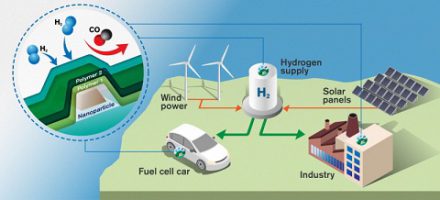PolymPart: Researchers from Chalmers University of Technology, Sweden, with colleagues from Delft Technical University, the Technical University of Denmark and the University of Warsaw, have developed ultra-fast hydrogen sensors that could the future performance targets for use in hydrogen-powered vehicles.

In a paper in the journal Nature Materials, the team presents a plasmonic metal–polymer hybrid nanomaterial concept, in which the polymer coating reduces the apparent activation energy for hydrogen transport into and out of the plasmonic nanoparticles, while deactivation resistance is provided via a tailored tandem polymer membrane.
In concert with an optimized volume-to-surface ratio of the signal transducer uniquely offered by nanoparticles, this enables sub-second sensor response times. Simultaneously, hydrogen sorption hysteresis is suppressed, sensor limit of detection is enhanced, and sensor operation in demanding chemical environments is enabled, without signs of long-term deactivation.
The sensor works based on an optical phenomenon—a plasmon—which occurs when metal nanoparticles are illuminated and capture visible light. The sensor simply changes color when the amount of hydrogen in the environment changes.
In a hydrogen economy with hydrogen gas as a clean and sustainable energy carrier, hydrogen sensors will play a critical role due to hydrogen’s wide flammability range in air. For safety reasons, any leaks in hydrogen energy storage systems, vehicles and appliances, as well as the entire hydrogen distribution infrastructure, must be detected immediately. Hence, hydrogen sensor performance targets specify a response time of 1 s at room temperature, across the concentration range from 0.1% to 10%.
… In the quest to meet these challenging targets, optical nanoplasmonic hydrogen sensors based on hydride-forming metal nanoparticles have been introduced. … In this field, like in many other hydrogen sensor platforms, Pd is the functional material of choice. This is due to its ability to dissociate hydrogen gas efficiently at ambient conditions and its reversible phase transformation from metal to metal hydride at room temperature which gives rise to a sizable optical contrast15. However, among several other drawbacks, such as hysteretic behaviour and response times falling short of the target value, the problem that hydrogen dissociation on Pd is effectively poisoned even by trace amounts of species like CO and NO2 remains widely unsolved, in particular in combination with other critical sensor metrics. This is problematic because CO, for example, is omnipresent at ~0.2 ppm, and at even higher concentrations close to large point sources or in urban areas.
The plasmonic metal–polymer optical hydrogen sensor platform presented here overcomes all these long-standing limitations by capitalizing on generic and synergistic effects that arise from combining PdAu alloy plasmonic nanoparticle signal transducers with tailored thin polymer membrane layers.
—Nugroho et al.
The plastic around the tiny sensor is not just for protection, but functions as a key component. It increases the sensor’s response time by accelerating the uptake of the hydrogen gas molecules into the metal particles where they can be detected. At the same time, the plastic acts as an effective barrier to the environment, preventing any other molecules from entering and deactivating the sensor. The sensor can therefore work both highly efficiently and undisturbed, enabling it to meet the rigorous demands of the automotive industry—to be capable of detecting 0.1 percent hydrogen in the air in less than a second.
We have not only developed the world’s fastest hydrogen sensor, but also a sensor that is stable over time and does not deactivate. Unlike today’s hydrogen sensors, our solution does not need to be recalibrated as often, as it is protected by the plastic.
—lead author Ferry Nugroho, a researcher at the Department of Physics at Chalmers
Detecting hydrogen is challenging in many ways. The gas is invisible and odorless, but volatile and extremely flammable. It requires only four percent hydrogen in the air to produce oxyhydrogen gas, sometimes known as knallgas, which ignites at the smallest spark. In order for hydrogen cars and the associated infrastructure of the future to be sufficiently safe, it must therefore be possible to detect extremely small amounts of hydrogen in the air. The sensors need to be quick enough that leaks can be rapidly detected before a fire occurs.
Although the aim is primarily to use hydrogen as an energy carrier, the sensor also presents other possibilities. Highly efficient hydrogen sensors are needed in the electricity network industry, the chemical and nuclear power industry, and can also help improve medical diagnostics.
In the long run, the hope is that the sensor can be manufactured in series in an efficient manner, for example using 3D printer technology.
The research was funded by the Swedish Foundation for Strategic Research, within the framework of the Plastic Plasmonics project.
Resources
Ferry A. A. Nugroho, Iwan Darmadi, Lucy Cusinato, Arturo Susarrey-Arce, Herman Schreuders, Lars J. Bannenberg, Alice Bastos da Silva Fanta, Shima Kadkhodazadeh, Jakob B. Wagner, Tomasz J. Antosiewicz, Anders Hellman, Vladimir P. Zhdanov, Bernard Dam & Christoph Langhammer (2019) “Metal–polymer hybrid nanomaterials for plasmonic ultrafast hydrogen detection” Nature Materials doi: 10.1038/s41563-019-0325-4

1 نظرات
[…] Researchers develop concept for ultra-fast hydrogen sensor; plasmonic metal–polymer hybrid nanomat… […]